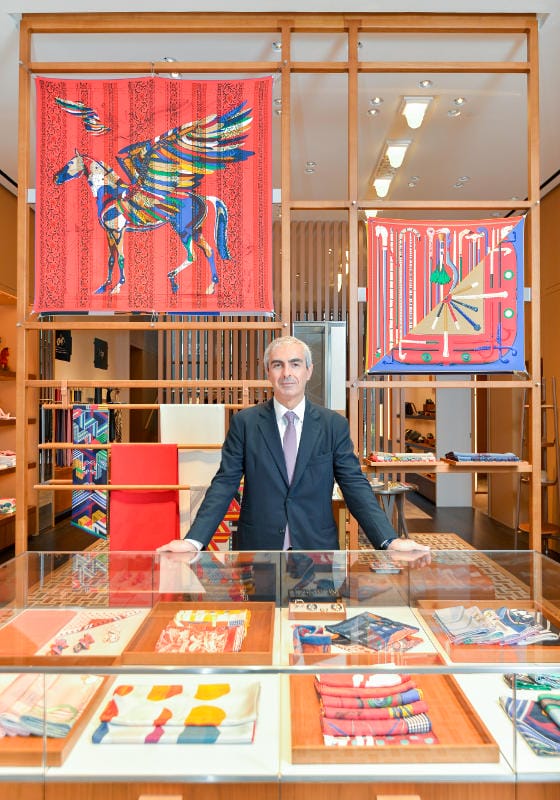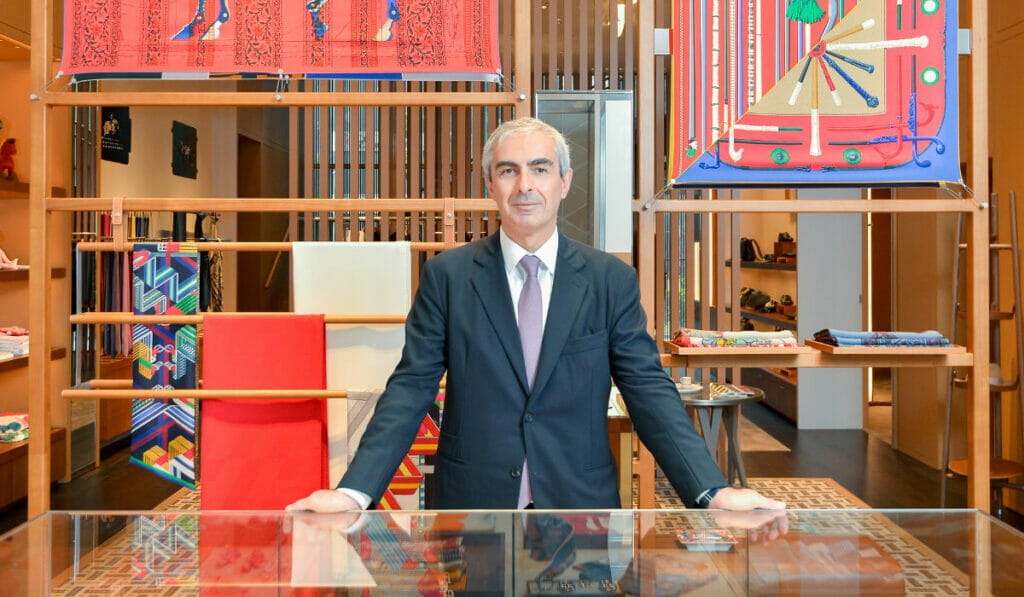The newly renovated Hermès flagship in Pavilion Kuala Lumpur under the artistic direction of Denis Montel of RDAI Paris has since had accolades pouring in for its new use of its 254 sq m space. The store features all of the Parisian house’s 16 metiers, including a maison (home) section on the ground floor. Through its main entrance, visitors are immediately taken by the house’s signature Faubourg pattern stoneware mosaic floor in contrast with a dark chocolate teak floor for a touch of Malaysiana. An impressive glass back façade baths the store in a natural light and is showcased with a lacquered metal square claustra extending from floor to ceiling.
“It’s a big challenge for us whenever we renovate our stores for many reasons. We are well known, of course, for our leather, but we are also selling watches, jewellery, ready-towear and accessories, and it’s quite a challenge to give a full representation because of limited physical space. So for architects and designers, it’s always something quite tricky,†says Eric Festy, Regional Managing Director of Hermès Middle East & South Asia, who was on hand to welcome media for a special preview.

Eric Festy, Regional Managing Director of Hermès Middle East & South Asia.
“The second thing is that we want to bring a local touch to our stores. Each store is very different – we want to bring a (character). This store has colours like chocolate and caramel, which are very attractive. We are also very keen on light and want to incorporate it in the store. We have the luck to benefit from daylight here, and it makes a lot of difference in the conception of the stores. You can also really feel the volume and the space now. Lastly, we expect our friends and customers to feel great comfort in these premises.â€
Festy, however, would prefer to think of the renovation as a metamorphosis. He elaborates in this interview.
Can you tell us the reasons behind the recent renovations? Why was there a need to – as you said – metamorphosise?
Hermès is a house where creation is very important. We renew very regularly, in fact twice a year, in a majority of our collections. When you think about it, what we used to sell 10 years ago versus what we sell now has changed a lot. We have some product categories which have emerged like ready-to-wear and fashion accessories. We need more space for these products knowing that, at the same time, we want to give full representation to our 16 metiers. We think, generally, between eight to 10 years, it’s good timing to do it. It’s a kind of update and upgrade of our stores.
Why metamorphosis and not renovation?
We have very talented designers and architects. Actually, it’s the same company that we’ve been working with for more than 40 years. When you look at the architectural concept of Hermès , we are one of the rare brands, if not the only one, who hasn’t changed the concept in 40 years. All the other brands have had quite a disruption. We never did it. Yet, this store is different from the previous one. The next one somewhere in the world will be even more different, and each store is an opportunity to bring something new in terms of colours and materials.
In the particular case of Kuala Lumpur, what is amazing is that we are staying in the same location, same size, same configuration on two floors. Still, when you walk through our doors now, you have the feeling of being in a totally different place compared to the previous one.
Some brands embrace disruption. Is Hermès one of them?
This is a key question. We used to say evolution, no revolution! In other words, we have a history, we have roots, all these we want to keep. At the same time, we are a company that is very contemporary in the sense that we change regularly – the concept and design is a good example, so is the product. In Forbes’ ranking of innovative companies, Hermès is always ranked in the top 30, which is quite surprising- it is the only luxury brand in this ranking because they understood that, in fact, Hermès is a very innovative company. If you want to renew twice a year, you have to be innovative. Otherwise, you are dead.
It is not just for the sake of innovating, either. It is part of the DNA of this company. In fact, in the early 19th century, Charles-Émile Hermès was already a great innovator, always changing his products and adapting them to the needs of the customer. In the beginning, Hermès was a harness maker, not yet a saddle maker. Then, it was understood that the customer needed to have saddles so they shifted to producing that. And then, the whole equestrian world. Then, they realised that the car would ‘kill’ the horse, so they started to accompany this movement with travelling objects, leisure and so on.
Tell us about the importance of a physical store vis-a-vis the current retail climate we are experiencing. Is it being challenged?
I don’t see it as an issue, more as a complementary experience. To be online gives you the possibility to make a quick purchase. It’s good when you know the product, when you know what you’re looking for, and you don’t want to spend hours in the jam to go to the store to buy a scarf or tie. Coming into the physical store is totally different because you can survey, see the colours, feel the materials, you can try the scent of the perfumes. I think there is room enough for the two of them.
What is the most striking feature about this store?
Personally, I love the daylight. We are lucky to have a double floor, height and daylight. That brings a lot to this store, a new energy. We moved the staircase, which was in the centre of the store and was very prominent and taking a lot of space, so we had the idea to move it along the façade, which really frees up the space. The atmosphere is much warmer with this colour scheme and the tones of beige, brown, chocolate. I’m a fan of chocolate and caramel, so I feel a lot of good energy in the store.
I would say the store is pretty balanced. We have more room now for watches and jewellery – we have a better capacity to display them. The same goes for the maison (home) downstairs. The second floor can be considered an open space, where we can have a lot of people, but even if we have less people in the store, it can become a very nice, private and cosy area. This VIP room is also important because here is where you can have a more individual, face-toface relationship and a more bespoke attitude with the customer. We also want people to ‘feel’ well. When I say people, it’s not just our customers but also our staff as they spend the whole day here.
What kind of experience do you want Hermès to give your VIP customers?
It’s not easy to answer this question because we have such a wide range of products. We need to understand what customers’ wishes are. The need of someone who wants to buy a watch would be totally different from someone who wants to buy a scarf. It depends whether it is a gift or for yourself. So, I think what really matters is to take the necessary time to understand what our customer wants as both a service and product. When I joined the company a few years ago – I was selling in the Faubourg store in Paris – one of my associates used to tell me that I had to ask the customer five or six questions before selling them anything: Is it for you or is it a gift? If it’s a gift, is it for a blonde-haired or dark-haired person? You take the time to understand customers and what they want. Then you would be much more able to provide a service and to show the right product. Listening is the key element for the store.




